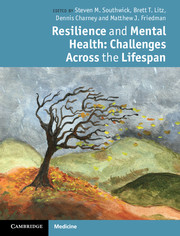Book contents
- Frontmatter
- Contents
- Contributors
- Preface
- Section 1 Pathways to resilience
- Section 2 Resilience across the lifespan
- Section 3 Resilience in families, communities, and societies
- 10 Family resilience: a collaborative approach in response to stressful life challenges
- 11 Community resilience: concepts, assessment, and implications for intervention
- 12 Trauma, culture, and resiliency
- Section 4 Specific challenges
- Section 5 Training for resilience
- Index
- References
11 - Community resilience: concepts, assessment, and implications for intervention
from Section 3 - Resilience in families, communities, and societies
Published online by Cambridge University Press: 07 September 2011
- Frontmatter
- Contents
- Contributors
- Preface
- Section 1 Pathways to resilience
- Section 2 Resilience across the lifespan
- Section 3 Resilience in families, communities, and societies
- 10 Family resilience: a collaborative approach in response to stressful life challenges
- 11 Community resilience: concepts, assessment, and implications for intervention
- 12 Trauma, culture, and resiliency
- Section 4 Specific challenges
- Section 5 Training for resilience
- Index
- References
Summary
Introduction
Although stress research has emphasized individual well-being, many types of stress are experienced collectively: the events bring harm, pain, and loss to large numbers of people simultaneously. Natural disasters, terrorist attacks, war, political oppression, epidemics, and economic recessions happen to whole communities and, sometimes, whole societies. This is not to say that all exposed individuals experience the event identically; in a disaster, one person may lose a loved one, while another loses a home, and another only a few possessions. Nor is this to say that all exposed individuals respond identically; a person’s psychological, social, and material resources powerfully shape his or her capacity to cope and function effectively. When stress pervades the community, however, these factors tell only part of the story. To have an ecologically valid understanding of mass trauma, we must recognize that survivors are connected and dependent upon one another’s coping strategies. Their attributions and actions reflect a host of social influences, social comparisons, and emergent norms. They help each other but also compete for scarce resources. Household preparedness is vital, but one household can no more prepare for disaster than it could, on its own, protect itself from crime or disease, educate its children, or keep the roads safe. Consequently, an individual’s resilience is inextricably linked to the community’s ability to prepare for, respond to, and adapt to adverse conditions. Simply put, when problems are shared, so must be solutions.
In recognition of such interdependencies, “community resilience” has emerged as a key concept for disaster readiness, although by no means limited to this one goal (Norris et al., 2008). This chapter will explore the concept of community resilience in some depth. Broadly, the chapter is organized into four sections. The first section provides our perspective on the meaning of resilience, including definitions that work across levels of analysis (individual, family, organization, community, society). The second section describes the adaptive capacities theorized to yield community resilience. This is followed by an outline of measurement strategies and challenges in assessing capacities, including some of our own pilot work. The concluding section makes recommendations for intervention and raises issues that need to be addressed in future research.
- Type
- Chapter
- Information
- Resilience and Mental HealthChallenges Across the Lifespan, pp. 162 - 175Publisher: Cambridge University PressPrint publication year: 2011
References
- 10
- Cited by



